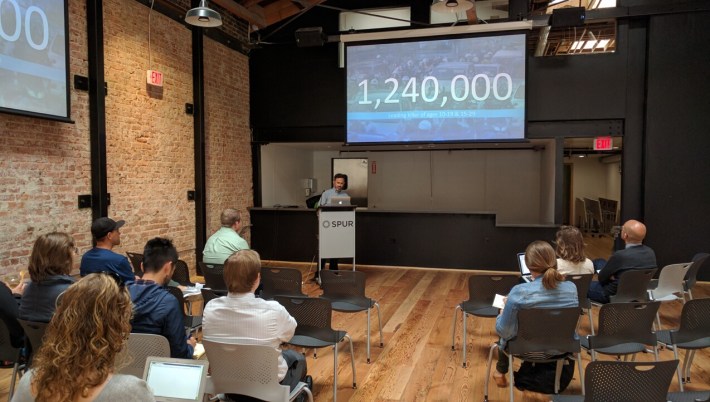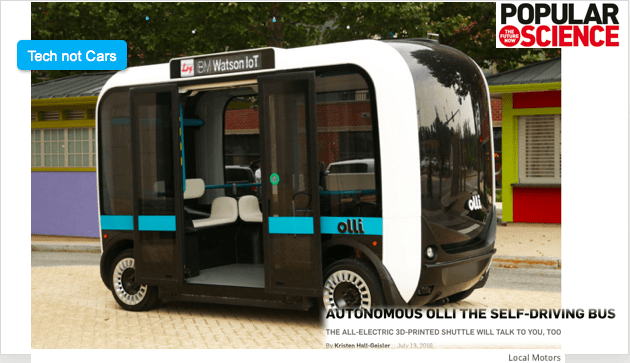SPUR Talk: Gabe Klein on Technology and Past and Future Cities
3:33 PM PDT on July 19, 2016

Gabe Klein, entrepreneur, writer and former head of transportation for Chicago and Washington DC, spoke yesterday afternoon at the Oakland office of the San Francisco Bay Area Planning and Urban Research Association (SPUR) about how technology can be guided to shape the future of our cities.
He put up a slide with a chilling number on it: 1.24 million--the number of people killed in car wrecks every year globally. That number will reach 3.6 million by 2030, as driving becomes more prevalent in the developing world. He wondered why people tolerate so much carnage. "We [the US] lost 35,000 people on the road last year--an increase of 10 percent because gas was cheap and people were driving more."
Sadly, those alarming numbers don't even account for deaths from automobile pollution or rising sea levels and other effects of global warming. "The transportation sector is spewing out more [greenhouse gas emissions] than everything else," Klein said. Global warming "...is man made. We're the only country with people who think it's not real; convenient if you're a Koch Brother, but not for the rest of us," he quipped.

Autonomous cars, in theory, should be safer. But before looking at purely technological fixes, he said it's imperative to dissuade rapidly developing countries from making the same mistakes. "We have an incredible opportunity to make better decisions and better choices to serve people in a different way. City states such as Singapore have not made as much investment in highways," he pointed out. It's also important, he said, to look at how cities formed before the advent of the automobile. "Cities have been around for ten thousand years...people want to be 10 minutes from their services, whether they walk, ride a horse [in a previous century] or ride a bike," he said.
In fact, he seemed to caution that old, low-tech solutions can still work to make a safe urban environment, once one understands the choices that led to today's dangerous, auto-centric cities. "Streetcars were the primary way neighborhoods were connected," he said, showing a slide of a streetcar stuck in traffic in a post-war city. "Transit was pretty fast until it was stuck behind cars." Which drove people away from streetcars, he explained, and, with the construction of freeways through downtowns, away from downtown areas as well. "We forced people to buy cars," he said. "Cars are not an asset you want to invest in, they are a depreciating asset...as we sold people more cars, there was a direct correlation to debt."
Fortunately, Klein points out that the reasons for car ownership are fading; smart phones and the sharing economy are key. "Bike sharing," he said, "is fascinating--shows you don't always need the super complex fix." But he cautions that there's a danger of getting overly obsessed with tech, especially with driverless cars, that could reboot an auto-centric paradigm of wide roads and sprawl. "The Libertarian bent in Silicon Valley and autonomous vehicles has to fit in the city that we want," he said. "The sprawling 1950s model just doesn't work; but what if you combine it [autonomous cars] with newer business models like Zip car, and newer services like Lyft?"
In this sense, he echoed sentiments of Professor Jason Henderson, who, in an editorial for Streetsblog, warned that driverless cars could end up increasing sprawl.
However, Klein warns that urban planners must not reject autonomous cars, because to do so would be futile: they are coming. To illustrate, he showed the now-infamous video of a Tesla driver asleep at the wheel, while its "autopilot" feature does the driving.
He suggested that government officials and advocates for livable streets need to get "in front" of the technology, to shape how autonomous vehicles are used. For example, he wants government agencies to work on integrating driverless taxis so they ferry people to transportation nodes. "We've got to get our act together and do it quickly," he said of cities. We need to "figure out rules and how to make it work together for the greater good." He also hopes "autonomous" vehicles will mean lightweight, electric cars and small buses, instead of heavy, conventional, highway-type vehicles. "I hope people wake up and realize they don't need a 7,000 pound Tesla."
He also praised the ability of autonomous cars to free up space from parking; he talked about a developer who designed a parking structure so that it can be re-arranged in the future into office space. He said he wants to see more developers anticipating that change.
"I'm trying to get people who are progressive to not be anti-tech," he said. "We have to shape this change or it will run us over."
Read More:
Stay in touch
Sign up for our free newsletter
More from Streetsblog San Francisco
SFMTA Starts West Portal Outreach
Agency presents plans to block traffic from crossing in front of the train station




